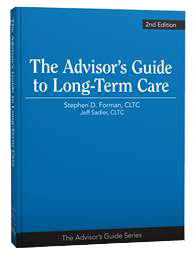Long Term Care Insurance Glossary
A.M. Best Rating
Independent judgment by the A.M. Best Company, a private organization that evaluates and monitors the financial strength and claims-paying ability of insurance companies. Similar services provided by Moody’s, Fitch, and Standard & Poor’s. While A.M. Best uses a range of fifteen (15) ratings, Moody's and S&P use ranges of twenty-one (21), therefore comparisons should be made with caution.
Activities of Daily Living (ADLs)
Seven basic actions performed by an independently functioning person on a daily basis: bathing, ambulation (mobility), toileting, continence, dressing, transferring (to and from a bed or chair) and eating. Generally, they are lost in this order. The inability to perform any 2 of 6 has been a standard benefit trigger in all qualified LTC policies since 1997.
Adult Day Services
Services provided during the day at a community-based center.
Chronically Ill
Term used in a tax-qualified long term care insurance policy to describe the need for extended care due to an inability to perform 2 of 6 Activities of Daily Living without standby or hands-on assistance, or due to a severe cognitive impairment. At a minimum, the condition is expected to last for at least 90 consecutive days.
Cognitive Impairment
A deficiency in short or long term memory; orientation to person, place and time; deductive or abstract reasoning; or judgment as it relates to safety awareness.
Community-Based Services
Services in the community (as opposed to an institutional setting), such as adult day services, home delivered meals, or transportation services. Often referred to as home and community-based services (HCBS).
Contingent Nonforfeiture
Policy provision automatically included in many newer policies, which provides a limited amount of continuing coverage even if the policy lapses due to non-payment of premium, if the non-payment is due to a significant increase in premium rates.
Custodial Care
Non-skilled service or care, such as help with bathing, dressing, eating, getting in and out of bed or chair, moving around, and using the bathroom. May also include care that most people do themselves, such as using eye drops. Medicare does not cover custodial care.
Daily / Monthly Benefit Maximum
Specified dollar amount that is the maximum amount reimbursable per period for covered services.
Elimination Period
Specified amount of time at the beginning of a disability during which covered services are received, but for which the policy will not pay benefits. Functions like a deductible.
Free-Look Period
A 30-day period (longer in some states) following receipt of a long term care insurance policy during which you may return it for any reason for a full refund of all premiums paid.
Guaranteed Purchase Option (GPO)
Form of inflation protection in a long term care insurance policy, where the insured has the right to increase benefits periodically (for example, annually or every three years) to reflect increases in the cost of care, without evidence of insurability.
Group Home / Adult Family Home
Residential private homes that are designed to provide housing, meals, housekeeping, personal care services, and supports to frail or disabled residents.
Guaranteed Renewable
Describes a policy that cannot be cancelled by an insurance company unless benefits have been exhausted or premiums not been paid as due. Rates may be changed only for all policyholders of a class in a state, but not due to one's age, change in health or claim status.
Hands-On Assistance
Physical assistance from another person, without which the individual would not be able to perform an Activity of Daily Living.
Homemaker/Chore Services
Homemaker/chore services can help you with general household activities such as meal preparation, bill paying, routine household care, and heavy household chores such as washing floors, windows or shoveling snow.
Hospice Care
Short-term, supportive care for the terminally ill (life expectancy of six months or less) that focuses on pain management, and emotional, physical, and spiritual support for the patient and family. May be inpatient or HCBS.
Inflation Protection
Provision of a long term care insurance policy by which benefits increase over time, either automatically or at the option of the insured, to help offset future increases in service costs. All tax-qualified policies must make an offer of 5% compound inflation.
Informal Care
Care provided by family members, friends, neighbors or other volunteers who are not typically paid to provide care.
Lapse
Termination of a long term care insurance policy when a renewal premium is not paid.
Lifetime Benefit Maximum
Total dollar amount payable under a long term care insurance policy. May be expressed in dollars or days, and is sometimes called a pool or pot of money.
Limited Payment Option
A premium payment option in which premiums are payable only for a set time period, such as ten years or until age 65.
Long Term Care Facility
Licensed facility that provides general nursing care to those who are chronically ill or unable to take care of daily living needs.
Long Term Care Services
Services that include medical and non-medical care to people with a chronic illness or disability. Long term care (LTC) helps meet health or personal needs. Most long term care assists people with Activities of Daily Living, such as dressing, bathing, and using the bathroom. Long term care can be provided at home, in the community, or in a facility.
Medicaid
Joint federal and state public assistance program for financing health care intended for those with low incomes or high medical bills relative to income and assets. By default, it is the largest public payer of long term care services in the US by far.
Medicare
Federal program established in 1965 which provides hospital insurance (Part A) and medical insurance (Part B) for individuals over age 65, or those with certain disabilities. The Part D Prescription Drug Program was established in 2006. Medicare does not cover long term or custodial care.
Medicare Supplement Insurance
Private insurance policy that covers gaps in Medicare coverage. Plans are standardized.
Non-Forfeiture Benefits
Policy feature that returns at least some of your premiums if you cancel your policy or let it lapse.
Outline of Coverage
Description of benefits, exclusions, and provisions of a long term care insurance policy.
Pension Protection Act of 2006
Federal law which allows tax-free exchanges from non-qualified annuities to pay for LTC insurance premiums (called 1035-exchanges).
Partnership Policy
Private LTC insurance policy that allows you to protect some or all of your assets from both Medicaid spenddown and estate recovery in the event you apply for Medicaid after exhausting your policy's benefits.
Reserves
To ensure solvency to pay future claims, an insurance company must set aside premiums in what are called "reserves". By regulation, such reserves must be safely invested in highly-rated financial instruments. Generally, when interest rates are higher, premiums will tend lower-- and vice-versa.
Interestingly, premiums collected "today" cannot be shown as earned income by the company. For example, if a company collects a $365 annual premium on January 1st, only $1 is considered earned, while the other $364 remains unearned. Each day, another $1 is earned as insurance is provided. By law, unearned premium is a liability until it's been earned, and is called "unearned premium reserves."
Once a particular claim is reported (or "opened"), the company must transfer and set aside money to pay that specific claim, based on their best estimates. Since this money is essentially "owed" to the prospective claimant, the company considers these "claim reserves" spent. As money owed to others, this too is a liability. In the meantime, even while held in a fiduciary capacity, the company still earns interest income on these funds.
A company must also consider claims which it anticipates in the future, but which have not yet been formally reported (called "incurred but not reported", or IBNR). These too are a liability. (A non-LTC example I found describes this best: a vitamin manufacturer has been producing contaminated products, slowly impacting the health of its users. Even if the injury is known-- or is becoming known-- the insurer is not yet aware of any specific claimants.)
To recap, for policyholders not on claim, we call them "active life reserves". To accomodate policyholders on claim, a company sets aside-- and occasionally strengthens-- "claims reserves".
Respite Care
Temporary care which is intended to provide much-needed time off for informal caregivers who ordinarily provide regular, ongoing care of the policyholder.
Shortened Benefit Period
Nonforfeiture option in a long term care insurance policy that reduces the benefit period, but retains the full daily or monthly maximums applicable.
Skilled Care
Nursing care (such as help with medications, caring for wounds) and therapies (such as occupational, speech, respiratory and physical therapy). Skilled care usually requires the services of a licensed professional (such as an RN, LPN, LVN, doctor or therapist).
Tax-Qualified Long Term Care Insurance
Policy that conforms to certain standards in federal law (IRC section 7702(b)) in order to qualify for federal tax advantages in both premium payments and benefits received.
Third Party Designee
Someone whom the insurance company would notify if your coverage is about to lapse due to non-payment. This can be a relative, friend, or professional, such as your attorney. You should always take advantage of the option to name one.
Underwriting
Process of approving, denying, or rating applications for insurance based on the fitness of an applicant. Helps to keep premiums low.
Waiver of Premium
Policy provision that suspends premium payments after a specified period of time, typically when the insured is receiving benefits. The suspension continues until recovery, at which time premium payments resume.





